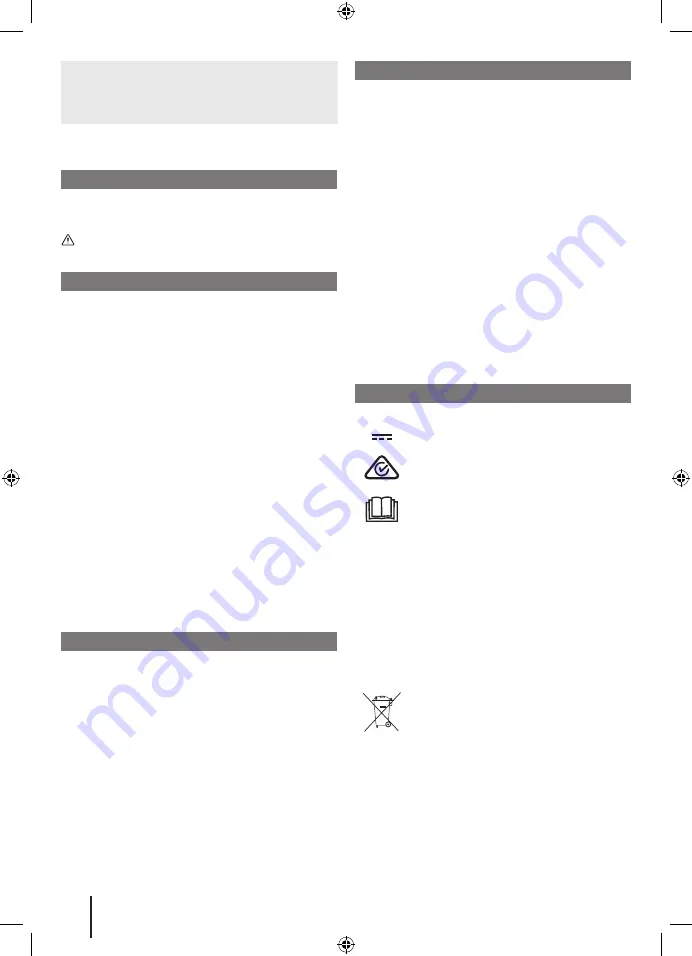
IMPORTANT!
It is essential that you read the instructions in this manual
before assembling, operating, and maintaining the product.
Subject to technical modifications.
Safety, performance, and dependability have been given
top priority in the design of your stick vac.
INTENDED USE
The stick vac is intended for dry vacuuming for household or
similar non-industrial applications.
Do not use the product for any other purpose.
WARNING!
Do not use the product to vacuum liquids
of any kind.
STICK VAC SAFETY WARNINGS
■
This appliance is not intended for use by persons
(including children) with reduced physical, sensory or
mental capabilities, or lack of experience and knowledge,
unless they have been given supervision or instruction
concerning use of the appliance by a person responsible
for their safety. Children should be supervised to ensure
that they do not play with the appliance.
■
The product is intended for household use only.
■
Never vacuum materials such as hot coals, cigarette
butts, matches, etc.
■
Do not use the product without dust bowl or filter in
place.
■
Use extra care when using the product on stairs.
■
Do not use the product to pick up hard objects such as
nails, screws, coins, etc. Damage or injury could result.
■
Remove battery when the product is not in use or when
changing accessories.
■
Rechargeable batteries are to be removed from the
product before being charged.
■
Exhausted batteries are to be removed from the product
and safely disposed of.
■
If the product is to be stored unused for a long period,
the batteries should be removed.
■
The supply terminals are not to be short-circuited.
ADDITIONAL BATTERY SAFETY WARNINGS
■
To reduce the risk of fire, personal injury, and product
damage due to a short circuit, never immerse your
tool, battery pack or charger in fluid or allow a fluid to
flow inside them. Corrosive or conductive fluids, such
as seawater, certain industrial chemicals, and bleach
or bleach-containing products, etc., can cause a short
circuit.
TRANSPORTING LITHIUM BATTERIES
Transport the battery in accordance with local and national
provisions and regulations.
Follow all special requirements on packaging and labelling
when transporting batteries by a third party. Ensure that
no batteries can come in contact with other batteries
or conductive materials while in transport by protecting
exposed connectors with insulating, non-conductive caps or
tape. Do not transport batteries that are cracked or leaking.
Check with the forwarding company for further advice.
MAINTENANCE
■
Use only original accessories and spare parts. Should
components need to be replaced which have not been
described, please contact an authorised service centre.
All repairs should be performed by an authorised service
centre.
■
Avoid using solvents when cleaning plastic parts. Most
plastics are susceptible to various types of commercial
solvents and may be damaged by their use. Use clean
cloths to remove dirt, carbon dust, etc.
■
Do not at any time let brake fluids, gasoline, petroleum-
based products, penetrating oils, etc., come in contact
with plastic parts. Chemicals can damage, weaken or
destroy plastic which may result in serious personal
injury.
CLEANING THE FILTER
Wash the filter one every three months.
■
Remove the filter from the filter assembly. Tap it over a
rubbish bin to remove dirt.
■
Rinse the filter with warm water until water comes out
clear.
■
Allow the filter to air dry at least 24 hours until fully dry.
SYMBOLS
V
Volts
Direct current
Regulatory Compliance Mark (RCM). Product
meets applicable regulatory requirements.
Please read the instructions carefully before
starting the machine.
Do not dispose of waste batteries, waste
electrical and electronic equipment as
unsorted municipal waste.
Waste batteries and waste electrical and
electronic equipment must be collected
separately.
Waste batteries, waste accumulators, and
light sources have to be removed from the
equipment.
Check with your local authority or retailer for
recycling advice and collection point.
According to local regulations, retailers
may have an obligation to take back waste
batteries and waste electrical and electronic
equipment free of charge.
Your contribution to the reuse and recycling
of waste batteries and waste electrical and
electronic equipment helps to reduce the
demand of raw materials.
Waste batteries, in particular containing
lithium, and waste electrical and electronic
equipment contain valuable and recyclable
materials, which can adversely impact the
environment and the human health if not
disposed of in an environmentally compatible
manner.
Delete personal data from waste equipment,
if any.
3
Original Instructions
Summary of Contents for R18XSV9
Page 1: ...FRONT PAGE R18XSV9...
Page 5: ...1 2 3 4 1 1 2 1 3 2 3 6 Getting started...
Page 6: ...x x 3 1 2 3 7 Operation...
Page 7: ...1 1 2 1 1 2 2 2 1 3 4 3 2 1 4 5 8 Maintenance...
Page 8: ...1 1 2 1 2 3 3 4 3 R18XSV9 MFH 5 9 Maintenance...
Page 9: ...1 1 2 1 2 3 4 R18XSV9 FH2 5 10 Maintenance...
Page 10: ...1 1 2 1 2 3 3 3 4 R18XSV9 FH3 5 11 Maintenance...
Page 11: ...3 1 3 6 7 12 Maintenance...
Page 13: ......
Page 14: ......
Page 15: ......
















